
The Amos Adams House is a historic house in the Newton Corner village of Newton, Massachusetts. Built in 1888, it is a prominent local example of Queen Anne architecture. It was listed on the National Register of Historic Places on September 4, 1986.
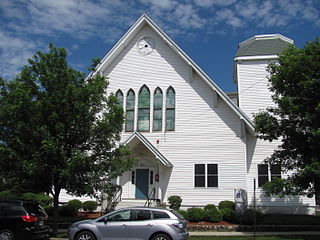
The First Unitarian Church is a historic former church building in Stoneham, Massachusetts. One of Stoneham's more stylish Gothic Revival buildings, the Stick style wood structure was built in 1869 for a Unitarian congregation that was organized in 1858. The building was listed on the National Register of Historic Places in 1984, and included in the Central Square Historic District in 1990. It presently houses the local Community Access Television organization.

The Samuel Chamberlain House is a historic house at 3 Winthrop Street in Stoneham, Massachusetts. Built c. 1864, it is one of three well preserved Italianate side-hall style houses in Stoneham. It was listed on the National Register of Historic Places in 1984.
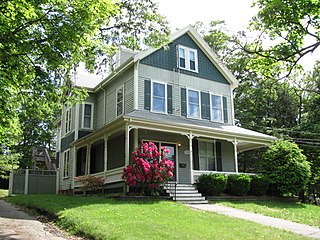
The Bernard Cogan House is a historic house at 10 Flint Avenue in Stoneham, Massachusetts, United States. Built about 1885, it is a good local example of Queen Anne style architecture in the United States. It was built for Bernard Cogan, the son of a local shoe factory owner. The house was listed on the National Register of Historic Places in 1984.

The James Cogan House is a historic house at 48 Elm Street in Stoneham, Massachusetts. It was built about 1890 for James Cogan, son of a prominent local shoe manufacturer, and is a prominent local example of Queen Anne architecture. The house was listed on the National Register of Historic Places in 1984.

The Dow Block is a historic commercial building on Central Square in Stoneham, Massachusetts. Built in 1864, it is the first of three mid-19th century buildings that define Central Square, and is a fine example of Second Empire architecture. The building was listed on the National Register of Historic Places in 1984, and was included in the Central Square Historic District in 1990.
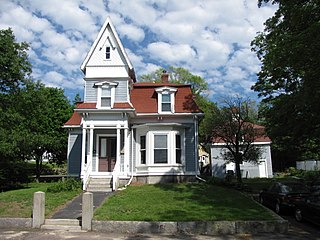
The E. A. Durgin House is a historic house at 113 Summer Street in Stoneham, Massachusetts. The two-story wood-frame Second Empire style house was built c. 1870 for E. A. Durgin, a local shoe dealer, and is one of Stoneham's most elaborately styled 19th century houses. Its main feature is a square tower with a steeply pitched gable roof that stands over the entrance. The gable of the tower is clad in scalloped wood shingles, and includes a small window that is topped by its own gable. The house has a typical mansard roof, although the original slate has been replaced with asphalt shingling, with a cornice that is decorated with dentil molding and studded by paired brackets.

The Michael Foley Cottage is a historic house at 14 Emerson Street in Stoneham, Massachusetts. It is a remarkably well preserved instance of a worker's cottage, built c. 1855. It was occupied until the 1870s by Michael Foley, a shoemaker who may have worked at the nearby Tidd shoe factory. It is a two-story wood-frame structure, with a front-gable roof, clapboard siding, and granite foundation. Its front facade has three narrow bays on the first floor and two on the second, with the entrance in the rightmost bay. Decorative woodwork is minimal.

The Franklin B. Jenkins House is a historic house at 37 Chestnut Street in Stoneham, Massachusetts. Built c. 1895, it is one of Stoneham's finest Queen Anne Victorian houses. The 2+1⁄2-story wood-frame house has an L shape, with a distinctive octagonal turret section at the crook of the L. A porch with turned posts and balusters wraps around the front and side to the turret section.

The Sidney A. Hill House is a historic house at 31 Chestnut Street in Stoneham, Massachusetts. The Queen Anne style Victorian wood-frame house was built c. 1895 for Sidney A. Hill, a partner in a shoe manufacturing business. The gables of the house feature Stick-style aprons and bands of cut shingles, and a porch that wraps around parts of the front and side of the house that features turned balusters and posts, and more Stick style detailing.
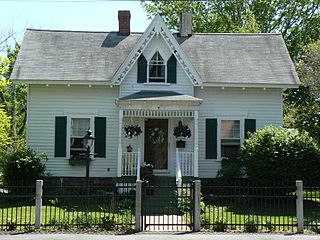
The House at 114 Marble Street in Stoneham, Massachusetts is a well-preserved Gothic Victorian cottage, built c. 1850. It is a 1+1⁄2-story wood-frame house with a rear ell, sheathed in wooden clapboards. It has a front gable centered over the main entry, which features turned posts and balusters, and a Stick-style valance. Windows in the gable ends have pointed arches characteristic of the style. The front gable is decorated with vergeboard.

The House at 19 Tremont Street is the smallest extant 19th century worker's cottage in Stoneham, Massachusetts. Built c. 1850, it is a stylistically vernacular single-story wood-frame structure, four bays wide, with a side gable roof, clapboard siding, and a brick foundation. Its only significant decorative features is its entry, which has sidelight windows typical of the Greek Revival period. It is the best surviving example of what was once a row of worker cottages that lined Tremont Street.
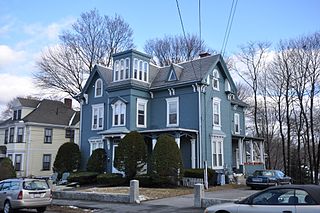
The Charles Wood House is a historic house at 30 Chestnut Street in Stoneham, Massachusetts. It is one of the most elaborate Italianate houses in Stoneham. The 2+1⁄2-story wood-frame house was built c. 1875 for Charles Wood, who lived there until the first decade of the 20th century. Its basic plan is an L shape, but there is a projecting section on the center of the main facade that includes a flat-roof third-story turret, and the roof line has numerous gables facing different directions. There are porches on the front right, and in the crook of the L, with Stick style decorations, the cornice features heavy paired brackets, some of its windows are narrow rounded windows in a somewhat Gothic Revival style, and the walls are clad in several types and shapes of wooden clapboards and shingles.

The Nobility Hill Historic District is a residential historic district roughly bounded by Chestnut and Maple Streets and Cedar Avenue in Stoneham, Massachusetts. The district includes a number of high quality houses representing a cross section of fashionable housing built between 1860 and 1920. It was added to the National Register of Historic Places in 1990.

The Warren Sweetser House is a historic house at 90 Franklin Street in Stoneham, Massachusetts. It is one of the finest Greek Revival houses in Stoneham, recognized as much for its elaborate interior detailing as it is for its exterior features. Originally located at 434 Main Street, it was moved to its present location in 2003 after being threatened with demolition. The house was found to be eligible for listing on the National Register of Historic Places in 1984, but was not listed due to owner objection. In 1990 it was listed as a contributing resource to the Central Square Historic District at its old location. It was listed on its own at its new location in 2005.

The Jesse Tay House is a historic house at 51 Elm Street in Stoneham, Massachusetts. The two-story wood-frame house, built c. 1810 for Jesse Tay, is one of Stoneham's best-preserved Federal style houses. It has a side-gable roof, asymmetrically placed chimneys, and a four-bay facade with irregular placement of windows and entrance. The entrance is sheltered by a portico with a fully pedimented gable, and square supporting posts. Ells project to the rear and left side. Tay was a farmer and shoemaker, and it is possible that one of the additions was used by him or other family members for the home-based manufacture of shoes.

The R.P. Turnbull House is a historic house at 6 Pine Street in Stoneham, Massachusetts. The ornately decorated Italianate house was built c. 1865 for R. P. Turnbull, a partner in the Tidd Tannery. The main block of the house follows a typical Italianate three-bay plan with a large central cross gable section on the roof. The central entry is sheltered by an elaborately decorated porch, and the flanking bay windows are topped by roof sections with decorative brackets. The main cornice is studded with paired brackets, and the gable ends have decorative shingle work around round-arch windows, with some Stick style decorative woodwork at the point of the gable.

The House at 380 Albion Street in Wakefield, Massachusetts is one of the finest Bungalow/Craftsman style houses in the town. It was built c. 1910 in a then-rural part of Wakefield that been annexed from Stoneham in the 1880s. The house was listed on the National Register of Historic Places in 1989.

The William Blodgett House is a historic house at 11 Fairmont Avenue in the Newton Corner neighborhood of Newton, Massachusetts. Built about 1875, it is a prominent local example of Stick style architecture. It was listed on the National Register of Historic Places in 1986, where it is listed at 645 Centre Street.

The William E. Alden House is a historic house at 428 Hamilton Street in Southbridge, Massachusetts. Built in 1882 for a prominent local businessman, it is a fine example of a modest home with Queen Anne and Stick style decoration. It was listed on the National Register of Historic Places in 1989.























